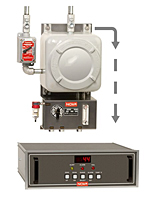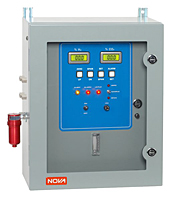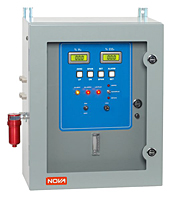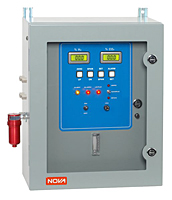|
|
|
|
| 名稱 |
產品展示 |
說明 |
備註 |
 4230N7MC過程分析儀 4230N7MC過程分析儀 |
 |
4230N7MC過程分析儀,氫與二氧化碳補償,壁掛式,防護NEMA7 UL/ CSA,非侵入式磁校準,防爆Class1,Div1,Group B,C,D
The Nova 4230 Process Hydrogen Analyzer has been specifically designed for the accurate measurement of H2 in exothermic or 'DX' gas from a furnace, generator, or other processes with high levels of H2 and CO2. The CO2 acts as an interference to the measurement of Hydrogen when using a thermal conductivity cell (T/C).
To correct the H2 reading for the presence of CO2, the 4230 has a separate infra red CO2 detector. Its purpose is to provide the exact amount of corrective signal for the Hydrogen reading, regardless of the furnace or generator conditions. This is a most desirable feature, especially when trying to obtain very accurate hydrogen readings.
Some manufacturers attempt to compensate the H2 reading for CO2 by advising the customer to obtain a calibration gas that also contains CO2. This approach is only effective at that particular H2/CO2 ratio. As soon as the process gas H2 level deviates from the calibration H2 level, the readings become more inaccurate. Continuous CO2 compensation is the only effective way to deal with this problem. |
|
 4230RM過程分析儀 4230RM過程分析儀 |
 |
4230RM過程分析儀,氫與二氧化碳補償,19英寸(483毫米)支架安裝在滑軌
The Nova 4230 Process Hydrogen Analyzer has been specifically designed for the accurate measurement of H2 in exothermic or 'DX' gas from a furnace, generator, or other processes with high levels of H2 and CO2. The CO2 acts as an interference to the measurement of Hydrogen when using a thermal conductivity cell (T/C).
To correct the H2 reading for the presence of CO2, the 4230 has a separate infra red CO2 detector. Its purpose is to provide the exact amount of corrective signal for the Hydrogen reading, regardless of the furnace or generator conditions. This is a most desirable feature, especially when trying to obtain very accurate hydrogen readings.
Some manufacturers attempt to compensate the H2 reading for CO2 by advising the customer to obtain a calibration gas that also contains CO2. This approach is only effective at that particular H2/CO2 ratio. As soon as the process gas H2 level deviates from the calibration H2 level, the readings become more inaccurate. Continuous CO2 compensation is the only effective way to deal with this problem. |
|
 4230PM過程分析儀 4230PM過程分析儀 |
 |
4230PM過程分析儀,氫與二氧化碳補償,面板安裝,滑動開啟易於訪問
The Nova 4230 Process Hydrogen Analyzer has been specifically designed for the accurate measurement of H2 in exothermic or 'DX' gas from a furnace, generator, or other processes with high levels of H2 and CO2. The CO2 acts as an interference to the measurement of Hydrogen when using a thermal conductivity cell (T/C).
To correct the H2 reading for the presence of CO2, the 4230 has a separate infra red CO2 detector. Its purpose is to provide the exact amount of corrective signal for the Hydrogen reading, regardless of the furnace or generator conditions. This is a most desirable feature, especially when trying to obtain very accurate hydrogen readings.
Some manufacturers attempt to compensate the H2 reading for CO2 by advising the customer to obtain a calibration gas that also contains CO2. This approach is only effective at that particular H2/CO2 ratio. As soon as the process gas H2 level deviates from the calibration H2 level, the readings become more inaccurate. Continuous CO2 compensation is the only effective way to deal with this problem. |
|
 4230N12過程分析儀 4230N12過程分析儀 |
 |
4230N12過程分析儀,氫與二氧化碳補償,壁掛式,防護等級NEMA12(IP52)
The Nova 4230 Process Hydrogen Analyzer has been specifically designed for the accurate measurement of H2 in exothermic or 'DX' gas from a furnace, generator, or other processes with high levels of H2 and CO2. The CO2 acts as an interference to the measurement of Hydrogen when using a thermal conductivity cell (T/C).
To correct the H2 reading for the presence of CO2, the 4230 has a separate infra red CO2 detector. Its purpose is to provide the exact amount of corrective signal for the Hydrogen reading, regardless of the furnace or generator conditions. This is a most desirable feature, especially when trying to obtain very accurate hydrogen readings.
Some manufacturers attempt to compensate the H2 reading for CO2 by advising the customer to obtain a calibration gas that also contains CO2. This approach is only effective at that particular H2/CO2 ratio. As soon as the process gas H2 level deviates from the calibration H2 level, the readings become more inaccurate. Continuous CO2 compensation is the only effective way to deal with this problem. |
|
 4230N4X過程分析儀 4230N4X過程分析儀 |
 |
4230N4X過程分析儀,氫與二氧化碳補償,壁掛式,耐腐蝕,防護等級NEMA4X(IP65)
The Nova 4230 Process Hydrogen Analyzer has been specifically designed for the accurate measurement of H2 in exothermic or 'DX' gas from a furnace, generator, or other processes with high levels of H2 and CO2. The CO2 acts as an interference to the measurement of Hydrogen when using a thermal conductivity cell (T/C).
To correct the H2 reading for the presence of CO2, the 4230 has a separate infra red CO2 detector. Its purpose is to provide the exact amount of corrective signal for the Hydrogen reading, regardless of the furnace or generator conditions. This is a most desirable feature, especially when trying to obtain very accurate hydrogen readings.
Some manufacturers attempt to compensate the H2 reading for CO2 by advising the customer to obtain a calibration gas that also contains CO2. This approach is only effective at that particular H2/CO2 ratio. As soon as the process gas H2 level deviates from the calibration H2 level, the readings become more inaccurate. Continuous CO2 compensation is the only effective way to deal with this problem. |
|
 4230N4過程分析儀 4230N4過程分析儀 |
 |
4230N4過程分析儀,氫與二氧化碳補償,壁掛式,防護等級NEMA4(IP65)
The Nova 4230 Process Hydrogen Analyzer has been specifically designed for the accurate measurement of H2 in exothermic or 'DX' gas from a furnace, generator, or other processes with high levels of H2 and CO2. The CO2 acts as an interference to the measurement of Hydrogen when using a thermal conductivity cell (T/C).
To correct the H2 reading for the presence of CO2, the 4230 has a separate infra red CO2 detector. Its purpose is to provide the exact amount of corrective signal for the Hydrogen reading, regardless of the furnace or generator conditions. This is a most desirable feature, especially when trying to obtain very accurate hydrogen readings.
Some manufacturers attempt to compensate the H2 reading for CO2 by advising the customer to obtain a calibration gas that also contains CO2. This approach is only effective at that particular H2/CO2 ratio. As soon as the process gas H2 level deviates from the calibration H2 level, the readings become more inaccurate. Continuous CO2 compensation is the only effective way to deal with this problem. |
|
|
|